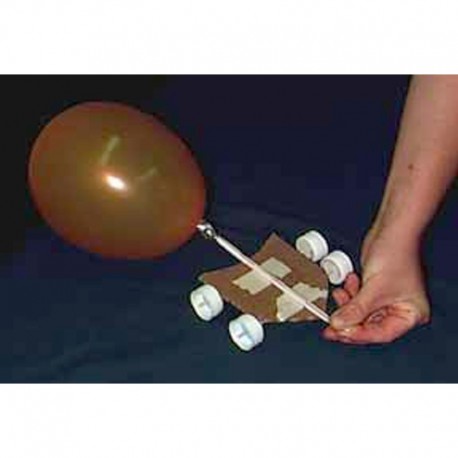 View larger
View larger
Rocket Car Distance Challenge
New activity
Using new and recycled materials, patrons construct rocket cars that use a balloon and straw “rocket” to move. Students will “race” the cars to see which can go the farthest before revising their design and “racing” again.
Open Activity
Teacher's Guide
Provides classroom connections, key concepts, connections to science standards, and additional resources.
-
Rating
-
Participants Enjoyed the ActivityParticipants Learned from This ActivityActivity Instructions Were Clear and Easy to FollowWould Recommend
Related Programming Resources
Reviews
A wild ride from start to finish
We ran this activity as a featured activity within our larger Monday Makerspace program, and it was a hit! In order for the end result to be a vehicle which actually moves on its wheels, however, the kiddos had to either master advanced principles of engineering or have access to willing parents who had done so. We allowed perhaps a little too much freedom at the top of the hour when we ran this program, and the littler kids spent a great deal of time crafting vehicles which looked awesome but didn’t go anywhere, and were then frustrated to learn they’d “failed” at one of the activity goals.
To reduce the likelihood of ya’all repeating this error, I’d suggest building a vehicle of your own to provide as a model, and demonstrating the “race” or “rocket-propelled” aspect of the activity before ever distributing the materials. That way, the goals are not just clearly defined, but are clearly *modeled* in a way that’s memorable. Some of the kiddos may even use your vehicle as a template, which is fine. Many kids, we’ve discovered, find starting from scratch with no model an incredibly daunting task—even if you show images of models, such as those provided under the “How-to Video” link, on the big screen while the craft is underway. An additional benefit to building your own vehicle beforehand is that you will grasp the basic architecture of axles and bushings much, much better, and be able to explain why hot gluing the axle directly to the bottom of your vehicle will not enable rapid travel. Or any travel at all.
One of the bonus features of this activity is that it pairs so well with others. We didn’t have time to run any other activities simultaneously with this one, but the week beforehand we ran the “Wind Turbine Tech Challenge” (http://clearinghouse.starnetlibraries.org/engineering/37-wind-turbine-tech-challenge.html) and the basic principles learned there (about torque, spin, and wind power in general) were foundational in building rocket cars with which the children were satisfied.
It’s worth mentioning that using words like “success” and “failure” in respect to this activity is probably more harmful than good. There are vehicles which travel, and vehicles which don’t, but as long as the kids themselves are happy with them, that’s all that matters.
The danger with a craft like this one is it can get very complicated, very quickly. There are loads and loads of recommended materials, and there are plenty of possible substitutes and additional materials you can use as well, to the point where the average librarian will probably have much of the necessary bits and pieces lying around in old crates and on back shelves already. It’s a craft which lends itself to chaos, and to really long programs.
A classic!
This is a fun and classic project. Kids really enjoy the challenge of having a specific goal in mind and using limited resources to reach that goal. That the goal was to build a race car made things extra fun. Kids hada great time testing various materials and designs to find the one that went the farthest.
The only challenge in the program is that kids had a hard to blowing up their balloons, so be prepared to help blow up a lot of balloons. Otherwise, keep a balloon hand pump on hand to assist with blowing the balloons up. Alternately, modify the design challenge somewhat, and have them create a vehicle with a sail, and use "wind power"- i.e. blowing air thru a straw- to race the vehicle.



